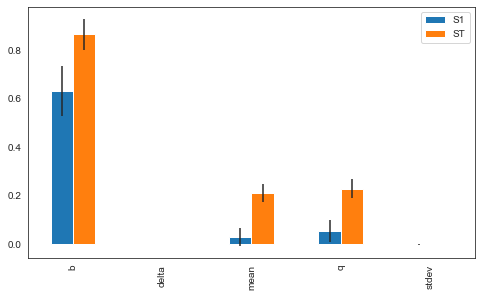"Since all models are wrong the scientist must be alert to what is importantly wrong. It is inappropriate to be concerned about mice when there are tigers abroad." George Box, 1976.
You must do SA. Just must. Why? Because it helps to:
- understand which parameters in your model matter (and which don't),
- debug the model,
- better plan policy interventions.
If you aren't convinced yet, here is a nice example of SA usage. So get some ☕, jump into 3-sa_demo_virus_on_network.ipynb and check how easy it is now!
What to expect from SA? Let's explain it with a figure that we borrowed from the EMA Workbench documentation.
Imagine an abstract model that have 5 parameters: b, delta, mean, q and stdev. And a single outcome of interest y. We run a fancy algorithm on it and get this: a barplot 🤯. This bar plot shows how impactful each of the parameters to our outcome of interest. The more the bar, the more the impact. For example, b is very impactful, while delta has no impact whatsoever. Each of the bars also has error bars in them representing confidence intervals. You can also notice that there are two types of bars: S1 and ST. These are Sobol indices. In short, S1 shows how much does a variable add to the variance of y on its own and ST shows how much does a variable add to the variance of y, including all its interactions? Tricky to understand at first, but don't worry, here is an extra reading material. To summarize, now we know which variables are "important" the most and to what extent: beta (the most impactful), mean and q (less impactful).
It's a collection of Jupyter Notebooks where we demonstrate how to use Variance-based sensitivity analysis aka Sobol on two famous agent-based models: Virus on a Network and Wolf-Sheep. These models are made with Mesa simulation package written in Python. But guess what? It can be a NetLogo model as well. And a Vensim model. And even an Excel model 🤯! To do the analysis we use EMA Workbench to perform experiments, SALib to do sensitivity analysis on Google Colab.
We tried to make the notebooks easy to understand and follow - it's just an introduction. Also, we hope that you can use them as templates to analyze your models ❤️. Use 3-sa_demo_virus_on_network.ipynb as the most comprehensive template.
You'll need a). Google Account and ... that's it. For the workshop, we will use Google Colab which allows us to run the code stored on GitHub in the cloud. Alternatively, you can use your local Python installation and environment.yml to recreate a virtual environment.
We ordered notebooks for the workshop, but you're free to take a look at any. Word live means that it will be used as a live-coding exercise during the workshop, notebooks with practice are made as small practical challenges and the word demo means that notebook is complete and can be used as a reference.
Here is the repo structure:
| 0-ema_demo.ipynb - short demo on how to use EMA Workbench
| 1-sa_live_virus_on_network.ipynb - live-coding with Raphael Klein
| 2-sa_practice_virus_on_network.ipynb - exercise for the participants
| 3-sa_demo_virus_on_network.ipynb - complete SA on the Virus on a Network
| 4-sa_practice_wolf_sheep.ipynb - second exercise for the participants
| 5-sa_demo_wolf_sheep.ipynb - complete SA on the Wolf-Sheep
|
+---results - saved experiments results
|
+---src - supplementary functions
|
+---virus_on_network - Virus on a Network Mesa model code
|
+---wolf_sheep - Wolf-Sheep Mesa model code
Raphael Klein @RaphaelKl1, Patrick Steinmann @steipat, Mikhail Sirenko @mikhailsirenko
And of course, we would like to thank Jan Kwakkel @jan_kwakkel and Marc Jaxa-Rozen for their practical and theoretical contribution into ideas and the code behind this workshop, core developers and contributors of EMA Workbench, Mesa: Agent-based modeling in Python 3+ and SALib.

